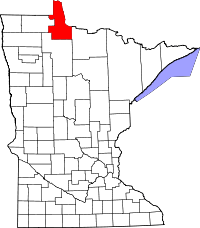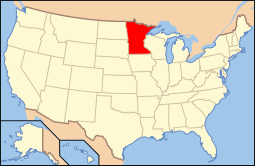Lake of the Woods County, Minnesota
| Lake of the Woods County, Minnesota | |
|---|---|
 Location in the U.S. state of Minnesota | |
 Minnesota's location in the U.S. | |
| Founded |
January 1, 1923(formed) 1922 (organized)[1] |
| Named for | Lake of the Woods |
| Seat | Baudette |
| Largest city | Baudette |
| Area | |
| • Total | 1,775 sq mi (4,597 km2) |
| • Land | 1,298 sq mi (3,362 km2) |
| • Water | 477 sq mi (1,235 km2), 27% |
| Population (est.) | |
| • (2015) | 3,923 |
| • Density | 3.1/sq mi (1/km²) |
| Congressional district | 7th |
| Time zone | Central: UTC-6/-5 |
| Website | Lake of the Woods County, Minnesota |
Lake of the Woods County is a county located in the U.S. state of Minnesota. As of the 2010 census, the population was 4,045,[2] making it the second-least populous county in Minnesota. Its county seat is Baudette.[3] The county was organized on November 28, 1922, though county functions did not begin until 1923.[4]
The county contains the Northwest Angle, the northernmost point of the Lower 48 States, and includes the U.S. portion of Lake of the Woods, shared with Canada. The county also includes the exclave of Elm Point. Since Alaska does not have any counties, Lake of the Woods is the northernmost county in the United States. It is also the only county in the United States with four words in its name, although there is a parish in Louisiana called St. John the Baptist Parish, and the U.S. Census Bureau treats parishes as county equivalents for census purposes.
History
Lake of the Woods County was named after the lake that covers a large portion of the county. Jacques de Noyon, a Frenchman who came from Trois Rivières, (Quebec), explored this area in 1688 and became the first European to view the lake. He named the lake Lac aux Îles which means "Lake of the Islands" in English.
In 1885 the region of Lake of the Woods got its first settler, Wilhelm Zippel, who was a German immigrant and a fisherman. He settled on the south shore of the lake in a place now called Zippel Bay. Shortly after, Alonzo Wheeler settled on a point on the southwest side of the lake which is now called Wheeler's Point.
A terrible wildfire, which has come to be known as the Baudette Fire of 1910, broke out in October of that year, burning 300,000 acres (1,200 km2) and destroying the towns of Spooner, Baudette, Graceton, Pitt, Williams, and Cedar Spur.[5] Lake of the Woods County was founded January 1, 1923, with Baudette as the original county seat. Lake of the Woods County is also known as Minnesota's youngest county. This county was organized on November 28, 1922, when residents voted to separate the northern Townships.
Geography
According to the U.S. Census Bureau, the county has a total area of 1,775 square miles (4,600 km2), of which 1,298 square miles (3,360 km2) is land and 477 square miles (1,240 km2) (27%) is water.[6]
Major highways
Adjacent counties and districts
- Kenora District, Ontario (northeast)
- Rainy River District, Ontario (northeast)
- Koochiching County (southeast)
- Beltrami County (south)
- Roseau County (west)
- Rural Municipality of Piney, Manitoba (west)
- Buffalo Point, Manitoba (west)
- Division No. 1, Unorganized, Manitoba (northwest)
Demographics
| Historical population | |||
|---|---|---|---|
| Census | Pop. | %± | |
| 1930 | 4,194 | — | |
| 1940 | 5,975 | 42.5% | |
| 1950 | 4,955 | −17.1% | |
| 1960 | 4,304 | −13.1% | |
| 1970 | 3,987 | −7.4% | |
| 1980 | 3,764 | −5.6% | |
| 1990 | 4,076 | 8.3% | |
| 2000 | 4,522 | 10.9% | |
| 2010 | 4,045 | −10.5% | |
| Est. 2015 | 3,923 | [7] | −3.0% |
| U.S. Decennial Census[8] 1790-1960[9] 1900-1990[10] 1990-2000[11] 2010-2015[2] | |||

As of the census of 2000, there were 4,522 people, 1,903 households, and 1,267 families residing in the county. The population density was 4 people per square mile (1/km²). There were 3,238 housing units at an average density of 2 per square mile (1/km²). The racial makeup of the county was 97.21% White/Caucasian, 0.29% Black/African American, 1.13% Native American, 0.24% Asian, 0.11% from other races, and 1.02% from two or more races. 0.64% of the population were Hispanic or Latino of any race. 26.2% were of Norwegian, 22.3% German, 8.9% Swedish, 5.8% American and 5.0% English ancestry according.
There were 1,903 households, out of which 29.20% had children under the age of 18 living with them, 57.40% were married couples living together, 5.30% had a female householder with no husband present, and 33.40% were non-families. 29.70% of all households were made up of individuals and 12.90% had someone living alone who was 65 years of age or older. The average household size was 2.35 and the average family size was 2.93.
In the county the population was spread out with 24.70% under the age of 18, 5.70% from 18 to 24, 25.10% from 25 to 44, 27.20% from 45 to 64, and 17.20% who were 65 years of age or older. The median age was 42 years. For every 100 females there were 101.00 males. For every 100 females age 18 and over, there were 102.60 males.
The median income for a household in the county was $32,861, and the median income for a family was $38,936. Males had a median income of $30,469 versus $24,813 for females. The per capita income for the county was $16,976. About 6.70% of families and 9.80% of the population were below the poverty line, including 8.30% of those under age 18 and 10.60% of those age 65 or over.
Communities
Cities
- Baudette (county seat)
- Roosevelt (partly in Roseau County)
- Williams
Townships
Although all the townships are named, as of 2001, there are no township governments. All the townships are officially part of unorganized territory.
- Angle Township
- Baudette Township
- Beaver Dam Township
- Boone Township
- Chilgren Township
- Cloverdale Township
- Eugene Township
- Forest Area Township
- Gudrid Township
- Hiwood Township
- Kiel Township
- Lakewood Township
- McDougald Township
- Meadowland Township
- Myhre Township
- Norris Township
- Noyes Township
- Park Township
- Pioneer Township
- Potamo Township
- Prosper Township
- Rapid River Township
- Rulien Township
- Spooner Township
- Swiftwater Township
- Township 157-30
- Township 158-30
- Victory Township
- Wabanica Township
- Walhalla Township
- Wheeler Township
- Zippel Township
Unincorporated communities
- Angle Inlet
- Arnesen
- Birch Beach
- Carp
- Clementson
- Faunce
- Graceton
- Hackett
- Lude
- Long Point
- Oak Island
- Penasse
- Pitt
- Sandy Shores
- Wheeler's Point
See also
| Wikimedia Commons has media related to Lake of the Woods County, Minnesota. |
- National Register of Historic Places listings in Lake of the Woods County, Minnesota
- Zippel Bay State Park
References
- ↑ "Minnesota Place Names". Minnesota Historical Society. Retrieved March 18, 2014.
- 1 2 "State & County QuickFacts". United States Census Bureau. Retrieved September 1, 2013.
- ↑ "Find a County". National Association of Counties. Retrieved 2011-06-07.
- ↑ "History of Lake of the Woods County". Lake of the Woods County Historical Society. Retrieved October 26, 2014.
- ↑ "The Fire of 1910". Lake of the Woods County Historical Society. Retrieved 2009-06-08.
- ↑ "2010 Census Gazetteer Files". United States Census Bureau. August 22, 2012. Retrieved October 21, 2014.
- ↑ "County Totals Dataset: Population, Population Change and Estimated Components of Population Change: April 1, 2010 to July 1, 2015". Retrieved July 2, 2016.
- ↑ "U.S. Decennial Census". United States Census Bureau. Retrieved October 21, 2014.
- ↑ "Historical Census Browser". University of Virginia Library. Retrieved October 21, 2014.
- ↑ "Population of Counties by Decennial Census: 1900 to 1990". United States Census Bureau. Retrieved October 21, 2014.
- ↑ "Census 2000 PHC-T-4. Ranking Tables for Counties: 1990 and 2000" (PDF). United States Census Bureau. Retrieved October 21, 2014.
External links
- Lake of the Woods County government’s website
- Local tourist bureau’s website
- Link to Woods Square woodlands
 |
R.M. of Piney / Division No. 1, Unorganized, Manitoba / Buffalo Point First Nation, Canada | Kenora District, Ontario, Canada and Rainy River District, Ontario, Canada |  | |
| Roseau County | |
|||
| ||||
| | ||||
| Beltrami County | Koochiching County |
Coordinates: 48°46′N 94°54′W / 48.77°N 94.90°W